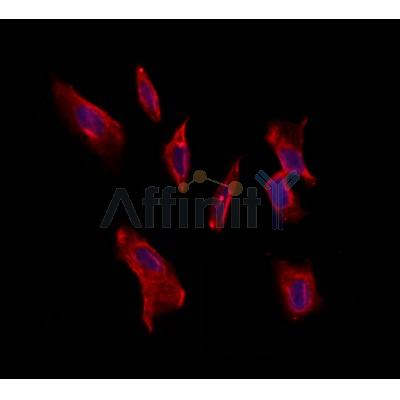Syndecan-3 Antibody - #DF12329
| Product: | Syndecan-3 Antibody |
| Catalog: | DF12329 |
| Description: | Rabbit polyclonal antibody to Syndecan-3 |
| Application: | WB IHC IF/ICC |
| Reactivity: | Human, Mouse, Rat, Monkey |
| Prediction: | Bovine, Horse, Sheep, Rabbit, Dog, Chicken |
| Mol.Wt.: | 60-70 kDa; 45kD(Calculated). |
| Uniprot: | O75056 |
| RRID: | AB_2845134 |
Related Downloads
Protocols
Product Info
*The optimal dilutions should be determined by the end user. For optimal experimental results, antibody reuse is not recommended.
*Tips:
WB: For western blot detection of denatured protein samples. IHC: For immunohistochemical detection of paraffin sections (IHC-p) or frozen sections (IHC-f) of tissue samples. IF/ICC: For immunofluorescence detection of cell samples. ELISA(peptide): For ELISA detection of antigenic peptide.
Cite Format: Affinity Biosciences Cat# DF12329, RRID:AB_2845134.
Fold/Unfold
N-syndecan; Sdc3; SDC3_HUMAN; SDCN; SYND3; Syndecan neural type; syndecan proteoglycan 3; Syndecan-3;
Immunogens
A synthesized peptide derived from human Syndecan-3, corresponding to a region within N-terminal amino acids.
- O75056 SDC3_HUMAN:
- Protein BLAST With
- NCBI/
- ExPASy/
- Uniprot
MKPGPPHRAGAAHGAGAGAGAAAGPGARGLLLPPLLLLLLAGRAAGAQRWRSENFERPVDLEGSGDDDSFPDDELDDLYSGSGSGYFEQESGIETAMRFSPDVALAVSTTPAVLPTTNIQPVGTPFEELPSERPTLEPATSPLVVTEVPEEPSQRATTVSTTMATTAATSTGDPTVATVPATVATATPSTPAAPPFTATTAVIRTTGVRRLLPLPLTTVATARATTPEAPSPPTTAAVLDTEAPTPRLVSTATSRPRALPRPATTQEPDIPERSTLPLGTTAPGPTEVAQTPTPETFLTTIRDEPEVPVSGGPSGDFELPEEETTQPDTANEVVAVGGAAAKASSPPGTLPKGARPGPGLLDNAIDSGSSAAQLPQKSILERKEVLVAVIVGGVVGALFAAFLVTLLIYRMKKKDEGSYTLEEPKQASVTYQKPDKQEEFYA
Predictions
Score>80(red) has high confidence and is suggested to be used for WB detection. *The prediction model is mainly based on the alignment of immunogen sequences, the results are for reference only, not as the basis of quality assurance.
High(score>80) Medium(80>score>50) Low(score<50) No confidence
Research Backgrounds
Cell surface proteoglycan that may bear heparan sulfate (By similarity). May have a role in the organization of cell shape by affecting the actin cytoskeleton, possibly by transferring signals from the cell surface in a sugar-dependent mechanism.
O-glycosylated within the Thr/Ser-rich region which could interact with lectin domains on other molecules.
Cell membrane>Single-pass type I membrane protein.
Expressed in the nervous system, the adrenal gland, and the spleen.
Belongs to the syndecan proteoglycan family.
Research Fields
· Environmental Information Processing > Signaling molecules and interaction > Cell adhesion molecules (CAMs). (View pathway)
Restrictive clause
Affinity Biosciences tests all products strictly. Citations are provided as a resource for additional applications that have not been validated by Affinity Biosciences. Please choose the appropriate format for each application and consult Materials and Methods sections for additional details about the use of any product in these publications.
For Research Use Only.
Not for use in diagnostic or therapeutic procedures. Not for resale. Not for distribution without written consent. Affinity Biosciences will not be held responsible for patent infringement or other violations that may occur with the use of our products. Affinity Biosciences, Affinity Biosciences Logo and all other trademarks are the property of Affinity Biosciences LTD.



